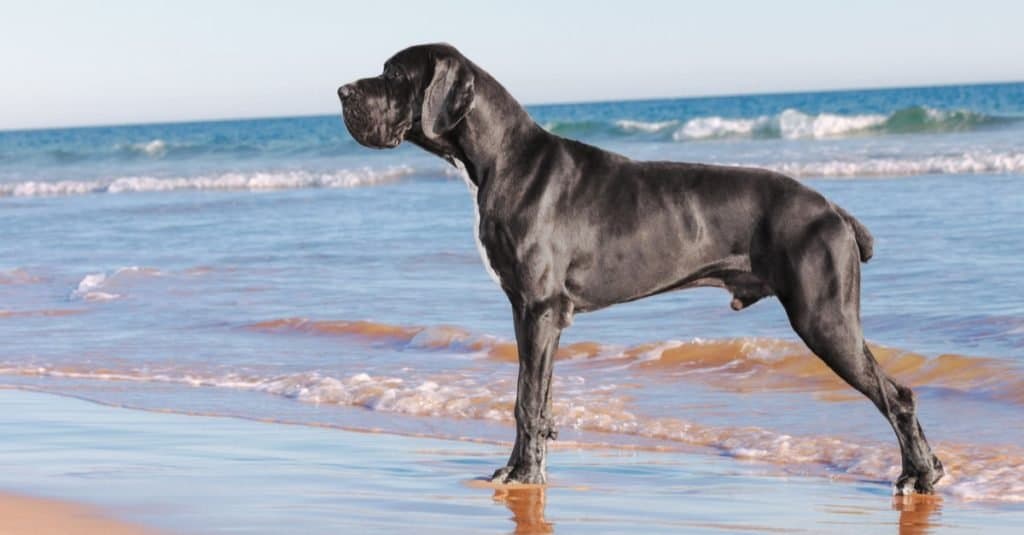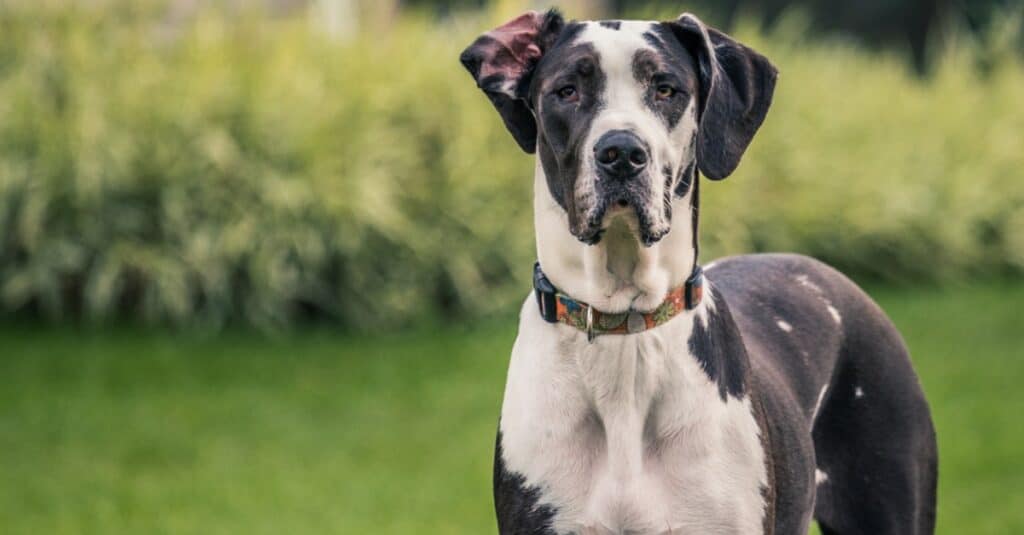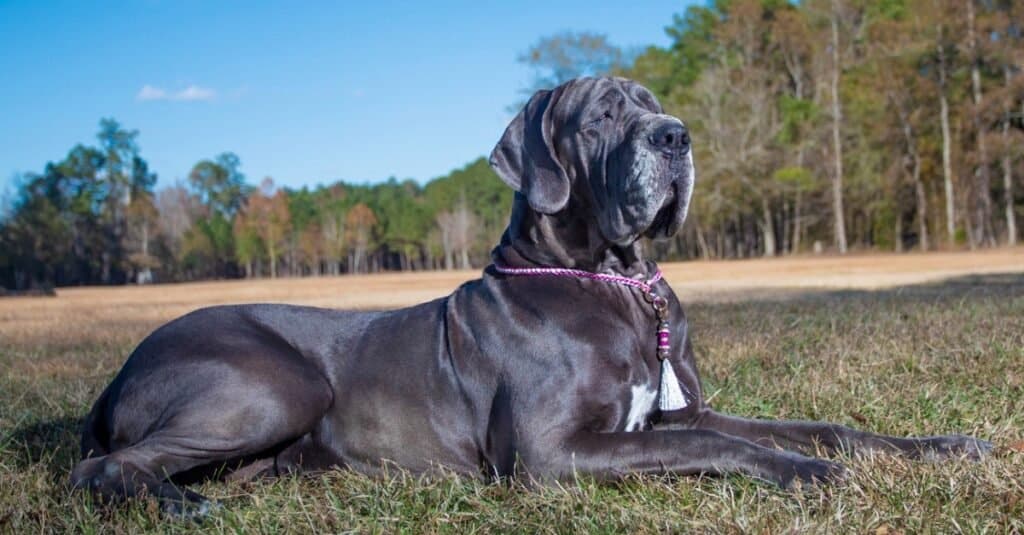Great Danes are giant-sized dogs known for their lithe bodies and protective natures. Since they were first bred all the way back in the 18th century, Great Danes have been looked at as majestic and beautiful creatures. However, someone had to have been around to clean up shed fur!
Great Danes shed moderately, but at their size, this means plenty of hair. They also have one to two shedding seasons each year when they shed more profusely. Luckily, their coats aren’t high-maintenance, requiring just a weekly once-over with a hound glove and the occasional bath.
During shedding season, they require a bit more work, as they should be brushed daily to reduce the amount of shed fur you find around the house.
Keep reading to learn more about these pups and their coats, including whether Great Danes are hypoallergenic and how to groom them.
Great Dane Coat Characteristics
| Coat Length | Short |
| Shedding Frequency | Moderate |
| Grooming Needs | Brush coat weekly |
| Fur or Hair? | Fur |
| Hypoallergenic? | No |
Are Great Danes Hypoallergenic?

Great Danes are not hypoallergenic.
©Al_Er/Shutterstock.com
Great Danes are not hypoallergenic. While they don’t shed excessively, they do shed year-round, with heavier shedding seasons in the spring and fall.
Hypoallergenic dogs tend to be so-called “non-shedding breeds,” which means they have human-like hair that sheds very rarely. These dogs tend to produce less dander, making them as allergy friendly as possible (though no dog is truly allergen-free).
Do Great Danes Drool?
Great Danes also drool heavily and have large mouths, meaning you’ll find drool puddles around the house and might need to wipe your pup’s face occasionally to keep it clean. Drool also contains allergens.
To manage drool, clean drooled-on areas with a mix of water and vinegar.
Place a mat beneath water bowls to lessen the spill on the floors – though, in my experience, you’ll never avoid it completely – so placing them on hard flooring and out of the way is ideal. People in your home, especially children, might slip if the paths you walk frequently remain wet.
Read the cleaning instructions on your dog’s toys, bedding, and other items and wash them regularly if possible to prevent odor.
How Do I Stop My Great Dane From Shedding?

You can lessen the amount of shedding from your Great Dane, but you can’t stop it entirely.
©Jose Arcos Aguilar/Shutterstock.com
While you can never stop your Great Dane from shedding entirely, you can lessen the amount of shed. Here’s how:
- Brush your Great Dane at least once a week and more often during shedding season.
- Use the right tools! The American Kennel Club recommends a medium-bristle brush, grooming mitt, or hound glove.
- Bathe your Great Dane with deshedding shampoo, especially during shedding season!
- Consider taking your dog to the groomers at the start of its shedding season to remove excess fur. You can also ask them for recommendations on how to keep up with your Great Dane’s coat.
You can also lessen the amount of fur around your house with the following:
- Vacuum attachments: My favorites are pet attachments with bristles at the end for brushing out hair and crevice tools with slanted ends, which are great for getting into the edges where the carpet meets the wall.
- Carpet rake: This will pull out stuck fur from your carpet, stairs, and other areas, keeping them cleaner than vacuuming alone.
- Handheld vacuum: These are lightweight and easier to use on stairs or furniture than an upright vacuum. You could also opt for an upright that comes apart to be used as a handheld.
- Furniture covers: You can purchase covers, which tend to be a bit pricier, or use throw blankets in places your Great Dane spends most of its time, such as its spot on the sofa or its favorite chair.
- Mesh laundry bags: Toss your pup’s bedding or your chair covers into these, and they’ll keep fur from lining your washing machine.
- Cleaning Routine: Having a routine will help you build cleaning up after your Great Dane into your daily life, making it easier to keep up with. For example, I vacuum the house each evening (I have multiple pets) and vacuum the stairs once a week.
How to Groom a Great Dane
Grooming your Great Dane isn’t only about its fur—it’s about keeping its whole body clean and healthy. I also like to incorporate quick health checks into grooming, so I can get to know what’s normal for my pets and catch any symptoms of illness early.
Here’s how to groom your Great Dane:
Brush Your Great Dane Once a Week

Your Great Dane should generally only need a quick brushing once a week.
©iStock.com/Earl-Wilkerson
Your Great Dane should generally only need a quick brushing once a week. However, since it’s a giant dog, this will take a bit of time!
Make sure you run the brush over its entire body until its coat looks smooth and free of dead hairs and debris. It’s best to brush in the direction the fur grows rather than going against the grain, as this can irritate some dogs.
This is also an excellent time to look at your pup’s body and skin. Check for lumps or swelling, redness or irritation of the skin, or pests in the fur.
Knowing what’s normal for your dog’s body is the best way of catching visible health problems early. It can literally be life-saving!
Bathe Your Great Dane As Needed
Great Danes’ coats don’t hold onto a ton of debris usually, since their fur is short and smooth. However, they’ll need to be bathed once in a while to stay clean.
You’ll know it’s time when their coat looks dirty or greasy, or they’re smelly.
Use a dog shampoo since other soaps can dry out their skin. I love oatmeal-based shampoos, but any made for dogs will work.
Get your pup’s whole body wet, then lather in the shampoo and rinse thoroughly. Be sure to get harder-to-reach areas like the armpits, stomach, and bottoms of the feet.
If you’d like, you can repeat this process with a dog conditioner to keep its fur and skin hydrated.
Since Great Danes are so big, it might be easier to wash them outdoors than in the tub. However, some dogs will dislike the hose if the water is too cold! Make your choice based on the season and your dog’s preferences.
Trim Your Great Dane’s Nails Monthly
If your Great Dane’s nails aren’t trimmed, they’ll eventually grow painfully into its paw pads. They might also catch on objects or break painfully. Even nails that aren’t quite so dramatically long can make walking painful or uncomfortable for your pup.
This is why trimming them at least once monthly is so important. You can also trim them more often if they’re long or sharp.
Here’s how to trim your Great Dane’s nails:
- Handle its paws first: When your Great Dane is relaxed, pet its paws. Once it’s used to this, move on to lifting them, spreading the toes, and touching the nails. You can also slowly introduce the clippers by allowing them to sniff and touching them to their feet before clipping any nails.
- Learn where the quick is located: This is the pink part at the base of each nail. The quick is full of blood and impossible to see on dark claws—making it extra important to know the anatomy of your dog’s nails.
- Trim just the ends of each nail, carefully avoiding the quick: If you’re uncertain at first, try to just cut the very tip. You can make multiple cuts or come back later to get them shorter.
- If you do cut into the quick, use flour or cornstarch to stop it from bleeding: If the bleeding doesn’t stop within a few minutes, see a veterinarian.
This is also a great time to check your dog’s feet for any splinters, scrapes, or dryness. Coconut oil can be used as a lotion to keep your Great Dane’s paw pads moisturized, though some pups love the taste and will lick it right off!
Clean Your Great Dane’s Ears Monthly or As Needed

Cleaning your Great Dane’s ears can help prevent ear infections.
©iStock.com/gsagi
Cleaning your Great Dane’s ears can help to prevent ear infections and excess wax build-up. Its ears can also get itchy if there’s too much wax or debris in them!
Most dogs need their ears cleaned around once a month, but if your dog has allergies or ear problems, your vet might recommend cleaning them more often.
Here’s how to clean a Great Dane’s ears:
- Flip the ears over, so you can see the underside: Hopefully, your pup’s ears aren’t cropped, but if they are, you can skip this step.
- Gather your supplies: You can use either dog ear cleaner or baby oil as your cleaning solution and a q-tip, cotton pad, cotton ball, or paper towel to apply it.
- Gently clean the underside of the ear, avoiding the ear canal: Never stick anything into the ear canal, as this can compact wax inside the ear or even damage the ear drum, causing great pain to your dog.
If you notice excess wax, redness, swelling, strange odor, or abnormal discharge, bring your Great Dane to veterinarians. They can professionally clean the inner ears, which you shouldn’t do at home. They can also diagnose any health concerns such as an ear infection or ear mites.
Brush Your Great Dane’s Teeth Weekly
Lastly, you should brush your Great Dane’s teeth weekly—or daily if you can manage. This might be the hardest part of grooming your pup, but it benefits it tremendously.
Brushing your dog’s teeth can help to avoid dental disease and save you thousands of dollars in vet visits throughout its life. Having a dog’s teeth removed is costly!
Here are some tips to make teeth brushing easier:
- Choose a yummy dog toothpaste: Never use human toothpaste on your dog, as it’s unsafe for it to swallow. Instead, select a toothpaste made for dogs—bonus points if the flavor is something your Great Dane loves, like chicken!
- Get it used to its mouth being touched: Open it gently, touch its teeth with your fingers, and provide lots of treats and praise when it cooperates! Keep seasons short before building up to longer amounts of time.
- Introduce the toothbrush slowly: Start by letting your Great Dane interact on its own, giving it treats for sniffing it or licking toothpaste from it. Then, slowly introduce the concept of it touching its mouth and rubbing against the teeth and gums.
- Work little by little: You don’t have to brush all of your dog’s teeth in one go. Start one small section at a time.
This is also a good time to look for any swelling, redness, tooth decay, or excess plaque. In addition to teeth brushing, veterinarians recommend a professional cleaning around once a year.
If your Great Dane absolutely won’t allow you to brush its teeth, try dental chews, and be sure to get it in for regular cleanings at the veterinarian.
Up Next:
- The Largest Great Dane Ever
- Great Dane Lifespan: How Long do Great Danes Live?
- Great Dane Size Comparison: Is this the Largest Dog?
The photo featured at the top of this post is © Ricantimages/Shutterstock.com
Ready to discover the top 10 cutest dog breeds in the entire world?
How about the fastest dogs, the largest dogs and those that are -- quite frankly -- just the kindest dogs on the planet? Each day, AZ Animals sends out lists just like this to our thousands of email subscribers. And the best part? It's FREE. Join today by entering your email below.
Sources
- American Kennel Club, Available here: https://www.akc.org/dog-breeds/great-dane/
- NexGard, Available here: https://nexgard.com.au/parasite/mites/does-my-dog-have-ear-mites#:~:text=Ear%20mites%20live%20in%20the,unpleasant%20odour%20from%20the%20ears.
- VCA Animal Hospitals, Available here: https://vcahospitals.com/know-your-pet/dental-disease-in-dogs
- VCA Animal Hospitals, Available here: https://vcahospitals.com/know-your-pet/ear-infections-in-dogs-otitis-externa#:~:text=Dogs%20with%20ear%20infections%20are,swelling%20that%20requires%20surgical%20treatment.
- AVMA, Available here: https://www.avma.org/resources-tools/literature-reviews/welfare-implications-ear-cropping-dogs
Thank you for reading! Have some feedback for us? Contact the AZ Animals editorial team.






